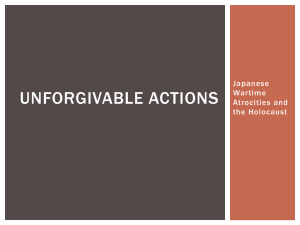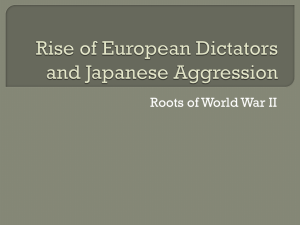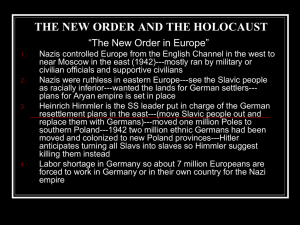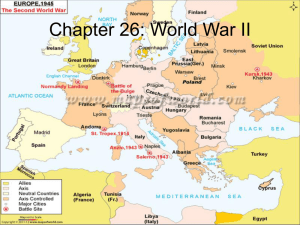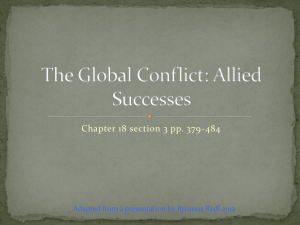09 TAJMT Chapter 12
advertisement
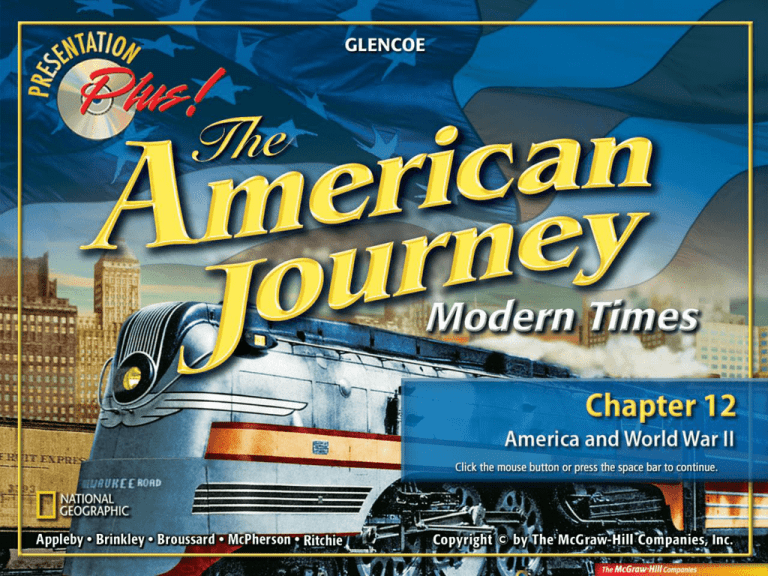
Chapter Introduction Section 1: The Road to War Section 2: War Begins Section 3: On the Home Front Section 4: War in Europe and Africa Section 5: War in the Pacific Visual Summary The Road to War Essential Question How did dictators acquire and expand power in Europe in the 1930s? War Begins Essential Question How did peaceful nations confront foreign aggressors in World War II? On the Home Front Essential Question In what ways did American men, women, and minorities support the war effort at home? War in Europe and Africa Essential Question What strategies did the Allies pursue in Europe and Africa to defeat the Axis Powers in World War II? War in the Pacific Essential Question What was the turning point in the war in the Pacific, and what led up to it? How did dictators acquire and expand power in Europe in the 1930s? Reading Guide Content Vocabulary • dictator • totalitarian • fascism • appeasement • anti-Semitism Academic Vocabulary • obtain • unify Reading Guide (cont.) Key People and Events • Benito Mussolini • Joseph Stalin • Munich Conference Rate your agreement with the following statement: The United States should take measures to stop dictators from ruling in other countries. 0% D D. Strongly disagree C C. Somewhat disagree B B. Somewhat agree A. A B. B C. C 0% D.0% D0% A A. Strongly agree The Rise of Dictators Bitterness over the outcome of World War I and serious economic problems led to the rise of dictators in several countries. The Rise of Dictators (cont.) • Adolf Hitler and other ruthless dictators rose to power by taking advantage of people’s fear, anger, and suffering in depressed economic times. • In Italy, Benito Mussolini made fascism popular and forced Italy’s king to name Mussolini the head of government. – Mussolini ended democratic rule and built up the military. Rise of Nazism The Rise of Dictators (cont.) • Adolf Hitler, leader of the National Socialist (Nazi) Party, blamed Jews for the problems in Germany, and his anti-Semitism led to unspeakable horrors. – Hitler ended democracy and established a totalitarian state. Rise of Nazism The Rise of Dictators (cont.) • Japanese leaders, feeling they did not have enough land or resources, invaded mineralrich Manchuria, a region of China, in 1931. • In 1940, Japan joined Germany and Italy in the “Axis” alliance. • Joseph Stalin—who rose to power in the Soviet Union in the late 1920s—used force to obtain obedience from his people. Rise of Nazism The Rise of Dictators (cont.) • In America, Congress passed the Neutrality Acts, which banned weapons sales and loans to nations at war. What was the name of Adolf Hitler’s political party? A. The Communist Party B. The Nazi Party 0% D A 0% A B C 0% D C D. The Socialist Party B C. The Fascist Party A. B. C. 0% D. Germany on the March Other European countries stood by as Germany expanded its territory. Germany on the March (cont.) • In March 1936, Hitler ordered German troops into the Rhineland. • Hitler insisted that Austria be unified with Germany and sent troops there in March 1938. Germany on the March (cont.) • When Hitler declared it Germany’s right to take over the German-speaking Sudetenland in Czechoslovakia, Britain and France tried to avoid war through appeasement. – At the Munich Conference, British and French leaders gave the Sudetenland to Germany in exchange for Hitler’s pledge that he would not expand any further. Germany on the March (cont.) – In March 1939, however, Hitler invaded the rest of Czechoslovakia. – Before invading Poland, Hitler signed the Soviet-German Non-Aggression Pact in August 1939. With what country did Germany sign a nonaggression pact? A. Czechoslovakia B. Britain 0% D A 0% A B C 0% D C D. Russia B C. France A. B. C. 0% D. How did peaceful nations confront foreign aggressors in World War II? Reading Guide Content Vocabulary • blitzkrieg • disarmament Academic Vocabulary • target • fund Reading Guide (cont.) Key People and Events • Allied Powers • Axis Powers • Winston Churchill • Atlantic Charter • Pearl Harbor Rate your agreement with the following statement: War could have been avoided if Europe’s leaders had not tried to appease Hitler. 0% D D. Strongly disagree C C. Somewhat disagree B B. Somewhat agree A. A B. B C. C 0% D.0% D0% A A. Strongly agree War in Europe World War II began in September 1939, when Germany invaded Poland, and Great Britain and France declared war on Germany. War in Europe (cont.) • France and Great Britain declared war on Germany after Hitler sent his armies into Poland on September 1, 1939. • The Germans called their swift and fierce attack on Polish targets a Blitzkrieg, or lightning war. America Prepares for War War in Europe (cont.) • In April 1940, the Netherlands and Belgium asked the Allied Powers—Britain and France—for help from the German attack but were soon overwhelmed. • In June 1940, the Germans crossed into France. Italy joined the Germans and attacked France from the southeast, and the French surrendered after German troops took Paris. America Prepares for War War in Europe (cont.) • Germany, Italy, and Japan formed the Axis Powers. • In August 1940, the Germans began bombing British air bases, shipyards, and cities. – Winston Churchill, the prime minister of Great Britain, provided inspiration to his people. America Prepares for War War in Europe (cont.) • In June 1941, German forces invaded the Soviet Union. – As the Soviets retreated, Stalin ordered a scorched-earth policy to make it harder for Germans to supply their troops and to keep advancing. America Prepares for War What was the Germans’ fast and fierce style of attack referred to as? A. The Allied Attack B. The Axis Attack 0% D A 0% A B C 0% D C D. Scorched Earth B C. Blitzkrieg A. B. C. 0% D. America and the War Wanting to defend democracy, the United States gradually became involved in the European conflict on the side of the Allies. America and the War (cont.) • Although he vowed to remain neutral, President Roosevelt prepared for war. – In 1938, Congress strengthened the navy. – The new Neutrality Act of 1939 allowed for warring nations to purchase American goods as long as they paid cash and carried the goods on their own ships. – In 1940, Roosevelt signed the Selective Training and Service Act, the first peacetime draft in United States history. America and the War (cont.) • Roosevelt ran for a third term as president in 1940 and won easily against Republican Wendell Willkie. • In March 1941, Congress passed the LendLease Act, which allowed the U.S. to sell, lend, or lease weapons to any country vital to the defense of the United States. America and the War (cont.) • In August 1941, Prime Minister Churchill and President Roosevelt drew up the Atlantic Charter, which set goals for the world after the destruction of the Nazis. – They urged disarmament and the creation of a “permanent system of general security.” Why were isolationists opposed to the Lend-Lease law? A. Loans to other nations would hurt the newly recovered economy. 0% 0% D A B C 0% D C A A. B. C. It would bring America closer to war. C. 0% D. It favored the Germans. D. B B. The U.S. might never get back the military equipment lent to other nations. The Japanese Threat The United States entered World War II as a result of Japan’s attack on the Pearl Harbor military base in 1941. The Japanese Threat (cont.) • While Hitler and Mussolini waged war in Europe, the Japanese made military conquests in the Far East. – Japan planned on taking the American territory of the Philippines. The Japanese Threat (cont.) • In response, Roosevelt froze all Japanese funds in U.S. banks and stopped the sale of oil, gasoline, and other resources that Japan lacked. • On December 7, 1941, Japanese warplanes attacked the American military base at Pearl Harbor, Hawaii. – More than 2,300 soldiers, sailors, and civilians were killed. Shock at Pearl Harbor The Japanese Threat (cont.) – The next day, the United States declared war on Japan. – Japan’s allies—Germany and Italy— declared war on the United States. – The United States joined the Allied nations and declared war on Germany and Italy. Shock at Pearl Harbor On which Axis power did the United States first declare war? A. Germany B. Italy 0% D 0% C A B C 0% D B D. Russia A C. Japan A. B. C. 0% D. In what ways did American men, women, and minorities support the war effort at home? Reading Guide Content Vocabulary • mobilization • civil defense • ration • internment camp Academic Vocabulary • shift • overseas Reading Guide (cont.) Key People and Events • WACs • WAVES • Tuskegee Airmen • bracero • Nisei Rate your agreement with the following statement: Women in the military should receive the same tasks as men. A D. Strongly disagree 0% 0% D C. Somewhat disagree A B C 0% D C B. Somewhat agree A. B. C. 0% D. B A. Strongly agree America Prepares The United States had to refocus its economy to provide supplies for the war effort. America Prepares (cont.) • More than 15 million Americans joined the armed forces during the war, both as volunteers and as draftees. • About 250,000 women served in the WACs (Women’s Army Corps), the WAVES (Women Appointed for Volunteer Emergency Service in the Navy), and women’s units in the marines, Coast Guard, and army air corps. America Prepares (cont.) • New agencies were created to speed up mobilization for war. – The War Production Board supervised automakers as they shifted from manufacturing cars to producing trucks, jeeps, and tanks. – The Office of Price Administration established limits on consumer prices and rents to prevent inflation. America Prepares (cont.) – The National War Labor Board helped resolve labor disputes that might slow down war production. • The Revenue Act of 1942 raised corporate taxes and required individuals to pay income taxes in order to help fund the war effort. Which of the following was NOT an agency created during World War II? A. The War Production Board 0% D 0% C D. The National War Labor Board A B C 0% D B C. The Office of Price Administration A. B. C. 0% D. A B. The Civilian Conservation Corps Wartime America During World War II, Americans faced hardships but united to help the war effort. Wartime America (cont.) • For many American families, the war meant separation from loved ones serving overseas. • With industries geared to producing goods to fight the war, Americans faced shortages of many consumer goods. • The government issued coupons for individuals to purchase certain items—such as gasoline and meat—that were rationed. Wartime America (cont.) • Many Americans helped the war effort by planting victory gardens, collecting scrap metal, or joining in civil defense. How did the American economy change when the U.S. entered World War II? A. Many women lost their jobs. B. Factories shifted to producing tanks. 0% D C B A A. A B. B C. African American workers C.0% C0% 0% faced discrimination. D. D D. The military began drafting workers. Women and Minorities World War II brought new opportunities to women and minorities, but inequalities remained. Women and Minorities (cont.) • Women were needed to fill the vacancies in the labor force left by men going to war. • About 1 million African Americans served in the armed forces during World War II. • The 332nd Fighter Group, known as the Tuskegee Airmen, shot down more than 200 enemy planes. Women and Minorities (cont.) • President Roosevelt established the Fair Employment Practices Commission to combat discrimination in industry. • Thousands of Native Americans left reservations to work in defense industries and serve in the armed forces. • A group of Navajo soldiers known as the “code talkers” used a special code based on the Navajo language to send messages that the Japanese could not decipher. Women and Minorities (cont.) • More than 250,000 Latinos served in the armed forces. • The bracero program recruited thousands of farm and railroad works from Mexico to work in American industry. Women and Minorities (cont.) • Although about two-thirds of Japanese Americans were Nisei—American citizens who were born in the United States—many people questioned their loyalty. – President Roosevelt directed the army to relocate more than 100,000 Japanese Americans who lived on the West Coast to internment camps. Women and Minorities (cont.) – In 1944 in Korematsu v. United States, the Supreme Court upheld the order providing for the relocation of Japanese Americans. What did the Supreme Court decision of Korematsu v. United States state? A. Internment camps were unconstitutional. 0% D 0% A D. Survivors of internment camps should receive $20,000. A B C 0% D C C. Japanese Americans could not join the U.S. military. A. B. C. 0% D. B B. Internment camps were constitutional. What strategies did the Allies pursue in Europe and Africa to defeat the Axis Powers in World War II? Reading Guide Content Vocabulary • siege • Holocaust • genocide • concentration camp Academic Vocabulary • concentrate • tense Reading Guide (cont.) Key People and Events • Dwight D. Eisenhower • George Patton • Operation Overlord • D-Day • V-E Day • Harry S. Truman Given the wartime situation, should Japanese Americans have been put into camps during World War II? A. Yes B. No A. A B. B 0% B A 0% North African Campaign Allied armies fought a successful campaign against Axis forces in North Africa. North African Campaign (cont.) • Allied leaders decided to concentrate on defeating Hitler before dealing with Japan. • Roosevelt and Winston Churchill agreed to attack Germany in North Africa first. – In November 1942, the British defeated German general Rommel at the battle of El Alamein. – British and American forces led by General Dwight D. Eisenhower drove the Germans out of North Africa in May 1943. North African Campaign (cont.) • American general George Patton and British general Bernard Montgomery took Rome, Italy, in June 1944. Who commanded the German forces in North Africa? A. Dwight D. Eisenhower B. George Patton 0% D A 0% A B C 0% D C D. Benito Mussolini A. B. C. 0% D. B C. Erwin Rommel The Tide Turns in Europe From 1944 to 1945, the Allies fought a two-front war in Europe to defeat the Nazis. The Tide Turns in Europe (cont.) • In 1941, German troops began a siege of Leningrad that lasted 900 days; however, the Germans could not take the city. • The Germans were also unsuccessful in their attempts to take Moscow, the Russian capital, and Stalingrad, a major industrial port. World War II in Europe and Africa The Tide Turns in Europe (cont.) • As the Soviets pushed toward Germany from the east, the Allies were tense as they prepared for Operation Overlord—the invasion of occupied Europe. • On June 6, 1944, or D-Day, the Allies began their invasion of Europe. • On August 25, 1944, French and American troops liberated Paris. D-Day, June 6, 1944 The Tide Turns in Europe (cont.) • The Germans counterattacked in Belgium, but were eventually defeated in the Battle of the Bulge. • Realizing the situation was hopeless, Hitler committed suicide in Berlin on April 30, 1945. D-Day, June 6, 1944 The Tide Turns in Europe (cont.) • Germany signed an unconditional surrender on May 7, and the Allies declared May 8 V-E Day for “Victory in Europe.” • President Roosevelt died suddenly on April 12, 1945, and Harry S. Truman became president. The day the Allies invaded France at the province of Normandy is known as what? A. Operation Overlord B. The Battle of the Bulge 0% D A 0% A B C 0% D C D. D-Day A. B. C. 0% D. B C. V-E Day The Holocaust The Nazis increased their persecution of the Jews and set up death camps in an effort to kill all of Europe’s Jewish population. The Holocaust (cont.) • The Nazis planned genocide—wiping out an entire group of people—of the Jews. • About 6 million Jews were killed in the Holocaust, along with millions of others— Slavs, Roma (Gypsies), communists, homosexuals, and people with handicaps. • When Hitler gained power in 1933, Jews were quickly deprived of their rights and citizenship. The Holocaust (cont.) • On November 9, 1938, the Nazis killed many Jews, burned Jewish places of worship, destroyed Jewish shops, and sent about 30,000 Jewish men to concentration camps. • The mass killing of Jews began when the German army invaded the Soviet Union in 1941. The Holocaust (cont.) • In January 1942, the Nazis agreed on what they called the “final solution” to destroy the Jews. – In death camps—such as Auschwitz and Treblinka—healthy prisoners became slave laborers, while the elderly, disabled, sick, and mothers and children were sent to the gas chambers. What people did the Nazis single out for total extermination? A. Jews B. Japanese 0% D A 0% A B C 0% D C D. Communists A. B. C. 0% D. B C. Czechs What was the turning point in the war in the Pacific, and what led up to it? Reading Guide Content Vocabulary • island hopping • kamikaze Academic Vocabulary • secure • conflict Reading Guide (cont.) Key People and Events • Douglas MacArthur • Bataan Death March • Battle of Midway • Guadalcanal • Battle of Leyte Gulf • V-J Day Should the United States have used the atomic bomb against Japan? A. Yes B. No A. A B. B 0% B A 0% The Pacific Front The Allies fought the Japanese for four long years in the Pacific. The Pacific Front (cont.) • On the same day the Japanese attacked Pearl Harbor, Japanese bombers struck American airfields in the Philippines and on the islands of Wake and Guam—key American bases in the Pacific. • American general Douglas MacArthur and his Filipino and American troops were forced to retreat to the Bataan Peninsula and the small island fortress of Corregidor. Amphibious Warfare The Pacific Front (cont.) • Allied troops surrendered after months of fierce fighting, and more than 20,000 of the troops died during the Bataan Death March to a prison camp. – General MacArthur had left for Australia to command Allied forces in the Pacific two months prior to the surrender in Bataan. Amphibious Warfare The Pacific Front (cont.) • James Doolittle’s bombing raid of Tokyo and the American victory in the Battle of the Coral Sea helped improve low American morale. • The navy destroyed four Japanese aircraft carriers and hundreds of airplanes in a victory at the Battle of Midway. War in the Pacific The Pacific Front (cont.) • General MacArthur and Admiral Chester Nimitz adopted a strategy know as island hopping—attacking and capturing certain key islands. – American forces met stiff resistance when fighting for control of Guadalcanal, but the Americans finally secured the island in February 1943. War in the Pacific The Pacific Front (cont.) – American forces captured Guam and neighboring islands in June 1944. – American ships destroyed most of the Japanese fleet at the Battle of Leyte Gulf in the Philippines in October 1944. • In March and June of 1945, American forces seized the islands of Iwo Jima and Okinawa. • In desperation, the Japanese unleashed suicide pilots known War in the Pacific as kamikazes. What is the capital city of the Philippines? A. Guam B. Guadalcanal 0% D A 0% A B C 0% D C D. Midway B C. Manila A. B. C. 0% D. The End of the War American use of the atomic bomb brought about Japan’s surrender in the Pacific conflict. The End of the War (cont.) • Although faced with certain defeat, the Japanese continued to fight. • President Roosevelt created a top-secret operation—the Manhattan Project—to create the first atomic bomb. • President Truman, who took office after Roosevelt’s death, regarded the atomic bomb as a military weapon and believed it was his duty to use it to save American lives. The End of the War (cont.) • The Allies issued the Potsdam Declaration, warning that if Japan did not surrender, they faced “prompt and utter destruction.” • On August 6, 1945, the Enola Gay dropped an atomic bomb on the Japanese city of Hiroshima. A second atomic bomb was dropped on Nagasaki three days later. – Between 80,000 and 120,000 people were killed in Hiroshima, and the Nagasaki bomb killed between 35,000 and 74,000 people. The End of the War (cont.) • Japan surrendered, and August 15, 1945, was proclaimed V-J Day for “Victory over Japan.” • World War II was the most destructive conflict in history, with more than 55 million people losing their lives. – American casualties—about 322,000 dead and 800,000 injured—were high, but light compared to other nations. For what event was the Potsdam Declaration a warning? A. The atomic bomb attack on Hiroshima 0% D 0% C D. The Midway invasion B C. The D-Day invasion A. A B. B C. C 0% 0% D. D A B. The attack on Pearl Harbor Section Transparencies Menu Daily Test Practice Transparency 26–1 Lesson Transparency 26A Select a transparency to view. Section Transparencies Menu Daily Test Practice Transparency 26–2 Lesson Transparency 26B Select a transparency to view. Section Transparencies Menu Daily Test Practice Transparency 26–3 Lesson Transparency 26C Select a transparency to view. Section Transparencies Menu Daily Test Practice Transparency 26–4 Select a transparency to view. Section Transparencies Menu Daily Test Practice Transparency 26–5 Select a transparency to view. dictator a leader who rules with total authority, often in a cruel or brutal manner fascism a political system, headed by a dictator, that calls for extreme nationalism and racism and no tolerance of opposition anti-Semitism hostility toward or discrimination against Jews totalitarian a political system in which the government suppresses all opposition and controls most aspects of people’s lives appeasement accepting demands in order to avoid conflict obtain to gain unify to join together blitzkrieg name given to the sudden, violent offensive attacks the Germans used during World War II; “lightning war” disarmament removal of weapons target an object of attack fund source of money mobilization gathering resources and preparing for war ration to give out scarce items on a limited basis civil defense protective measures taken in case of attack internment camp detention center where Japanese Americans were moved to and confined during World War II shift to move overseas across the ocean siege military blockade genocide the deliberate destruction of a racial, political, or cultural group Holocaust the name given to the mass slaughter of Jews and other groups by the Nazis during World War II concentration camps prison camps used to hold people for political reasons concentrate to focus one’s effort on something tense anxious or nervous island hopping a strategy used during World War II that called for attacking and capturing certain key islands and using these islands as bases to leapfrog to others kamikaze during World War II, a Japanese suicide pilot whose mission was to crash into his target secure gain control conflict disagreement; war or prolonged struggle To use this Presentation Plus! product: Click the Forward button to go to the next slide. Click the Previous button to return to the previous slide. Click the Home button to return to the Chapter Menu. Click the Transparency button from within a section to access the transparencies that are relevant to the section. Click the Return button in a feature to return to the main presentation. Click the History Online button to access online textbook features. Click the Reference Atlas button to access the Interactive Reference Atlas. Click the Exit button or press the Escape key [Esc] to end the chapter slide show. Click the Help button to access this screen. Links to Presentation Plus! features such as Maps in Motion, Graphs in Motion, Charts in Motion, Concepts in Motion, figures from your textbook, and Section Spotlight Videos are located at the bottom of relevant screens. This slide is intentionally blank.
